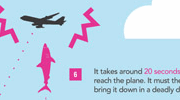AP 202: virtual academic posters
(The second of two articles about creating academic posters. See part 1.)
My professor friend in the college of Engineering at Notre Dame was shocked at the cost of printing academic posters, so he decided to “go green” and have students make electronic posters in the program of their choice. They will submit their work as Adobe PDF files, reducing worries about crossing platforms or lacking important fonts and software in the classroom.
My colleague also decided to take advantage of a new classroom with large flat panel displays on each wall. Groups of students will create the posters and during the presentation one poster will be displayed on multiple screens. Each member of the group will be stationed at a different screen to explain the content. This will require each student to be actively involved, instead of taking turns or designating one presenter.
I started to design a PowerPoint template that matched the shape of the screen, avoiding distortion and giving students the maximum workspace. Poster printers typically use 36″ rolled paper, so a poster fitting the 16 x 9 aspect ratio of the screen would be 64″ wide. That is larger than most academic posters and PowerPoint balks at anything wider than 54″. In the end, the project requirement will be a 36″ x 48″ poster in landscape mode. That gives the students the experience of creating a normal-sized poster without the cost of printing.
The issue of sharpness
Printed posters provide a much sharper image flat screens. An inexpensive printer will produce 300 dots per inch, while at maximum resolution our displays provide a paltry 37 pixels per inch. Three images side-by-side effectively measure 640 pixels each; a 6 MP photo is four times wider. The level of detail on a screen just can’t touch that of a printed poster.
Taking some of the edge off the sharpness issue, the physical setting should allow viewers to get close to the posters. My friend tested a number of PowerPoint posters and templates in the room and believes that the resolution will be fine.
New options
 Paper posters are often displayed in a public place for all to admire. Electronic posters will be more ephemeral unless shared on the Web. For example, students could upload posters to a site like Flickr for the entire world to admire. Collin Purrington (Swarthmore) has taken this one step further, creating a Flickr group called Pimp my poster, where poster creators receive feedback on their designs. read more about this here: Pimp my Poster: Crowdsourcing scientific poster design?
Paper posters are often displayed in a public place for all to admire. Electronic posters will be more ephemeral unless shared on the Web. For example, students could upload posters to a site like Flickr for the entire world to admire. Collin Purrington (Swarthmore) has taken this one step further, creating a Flickr group called Pimp my poster, where poster creators receive feedback on their designs. read more about this here: Pimp my Poster: Crowdsourcing scientific poster design?
Another opportunity that an electronic poster affords is the ability to incorporate animation. PowerPoint provides tools for this, but one could use a sophisticated tool like Adobe Flash to create an interactive display. Animation would not be printable, nor would it be as easy to share on a site like Flickr. My colleague chose not to offer animation as an option.
 Academic posters are not unlike infographics. Poster designers could benefit from browsing through the resources listed in our earlier article, Infographics in the classroom. On the other hand, it’s hard to come up with clever metaphors and not everyone has graphic design talents.
Academic posters are not unlike infographics. Poster designers could benefit from browsing through the resources listed in our earlier article, Infographics in the classroom. On the other hand, it’s hard to come up with clever metaphors and not everyone has graphic design talents.
Evaluation
I worked with my professor friend to create an assessment rubric specifically for this project. He has certain learning goals in mind and his students’ posters will not be the typical kind that describe experimental research. Still, creating the rubric ahead of time helped him frame the project. We hope some of you find the rubric useful as a starting point for your own project.
If you liked this article, why not subscribe to the blog?


Reblogged this on Academic / Scientific Posters and commented:
Part 2 of the 2011 post I just mentioned 🙂
I recently presented a poster via Skype (along with co-presenters who were physically present at the venue). We used prezi to make our poster. Not only is it a cool tool for making posters/presentations, but it also allows you to collaborate in real time while you are creating the poster.
I tested and it works here. Anyone else have problems?
The link to the PDF of the Assessment Rubric appears to be broken.